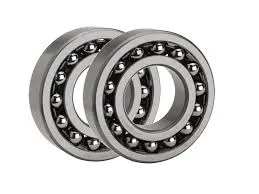
Nov . 10, 2024 05:50 Back to list
Optimizing Lubrication Techniques for Cylindrical Roller Bearings in Industrial Applications
Cylindrical Roller Bearing Lubrication Enhancing Performance and Longevity
Cylindrical roller bearings (CRBs) play a critical role in the smooth operation of various machinery and equipment, allowing for the effective support of radial loads with minimal friction. Proper lubrication is essential in ensuring these bearings function optimally, providing durability and extending their operational life. This article explores the importance of lubrication in cylindrical roller bearings, the various types of lubricants available, and best practices for application.
Importance of Lubrication
Lubrication in cylindrical roller bearings serves several critical functions. Firstly, it reduces friction between the rolling elements and the raceways, which minimizes wear and tear. This friction reduction is vital, as excessive friction can lead to increased temperatures, potentially damaging the bearings and adjacent components.
Secondly, lubrication helps to dissipate heat generated during operation. As bearings rotate under load, they generate heat due to friction. An effective lubricant can carry heat away from the contact surfaces, preventing overheating and maintaining optimal operating conditions.
Moreover, lubricants act as a barrier against contamination. Dust, dirt, and other particles can infiltrate the bearing housing, leading to abrasive wear. Proper lubrication forms a protective film that helps keep these contaminants at bay, reducing the risk of damage.
Types of Lubricants
Choosing the right lubricant for cylindrical roller bearings is crucial
. There are primarily two types of lubricants oils and greases, each with its advantages and applications.1. Oils Oil lubrication can be further classified into mineral oils, synthetic oils, and vegetable oils. Mineral oils are derived from refining crude oil and are widely used due to their availability and cost-effectiveness. Synthetic oils, on the other hand, offer enhanced properties such as better thermal stability, lower viscosity, and improved performance at extreme temperatures. Vegetable oils, being biodegradable, provide an environmentally friendly alternative but may not be suitable for all applications.
2. Greases Grease is essentially oil thickened with a soap or other thickening agent. It offers several advantages, such as better adhesion to surfaces, resistance to leakage, and reduced risk of contamination. Grease is often preferred in applications where continuous oil lubrication is impractical, such as in sealed bearings.
cylindrical roller bearing lubrication

Best Practices for Lubrication
To maximize the performance and longevity of cylindrical roller bearings, proper lubrication practices should be followed
1. Selection of Lubricant The choice of lubricant should be based on the operational conditions of the bearing, including load, speed, temperature, and environmental factors. Consult bearing manufacturers' specifications to determine the most suitable lubricant.
2. Quantity of Lubricant The amount of lubricant used is equally important. Insufficient lubrication may cause excessive wear, while over-lubrication can lead to overheating and increased drag. A good rule of thumb is to fill the bearing housing to about 30-50% of its free space with grease.
3. Lubrication Frequency Regular lubrication is essential for maintaining bearing performance. The frequency of lubrication depends on the operating conditions—higher loads and speeds may require more frequent lubrication. Monitoring temperature and vibration can help indicate the need for lubrication.
4. Monitoring and Maintenance Regular inspection of the lubrication condition, including checking for contamination and viscosity changes, ensures that the lubricant remains effective. Proper maintenance practices, including cleaning and replacing worn bearings, also contribute to the overall health of the lubricated system.
5. Temperature Management Keeping bearing temperatures within acceptable limits is essential. Heat can degrade lubricants and accelerate wear. Monitoring and controlling operating temperatures can significantly enhance bearing life.
Conclusion
In conclusion, lubrication is a vital aspect of the performance and longevity of cylindrical roller bearings. By understanding its importance, choosing the right lubricant, and following best practices for application and maintenance, operators can ensure optimal performance and reliability. Properly lubricated cylindrical roller bearings can withstand the rigors of operation, reduce downtime, and contribute to the overall efficiency of machinery, making lubrication an essential component of effective bearing management.
Latest news
-
Premium Deep Groove Ball Bearings | High Speed & Reliability
NewsAug.29,2025
-
Durable Scaffolding Clamps - Secure & Reliable Tube Connectors
NewsAug.28,2025
-
Common Failures in Thrust Ball Bearings and Solutions
NewsAug.22,2025
-
How Tapered Roller Bearings Can Take Shock Loads
NewsAug.22,2025
-
Angular Bearings in High-Precision Spindles
NewsAug.22,2025
-
The Impact of Misalignment on Cylindrical Roller Bearing Performance
NewsAug.22,2025
